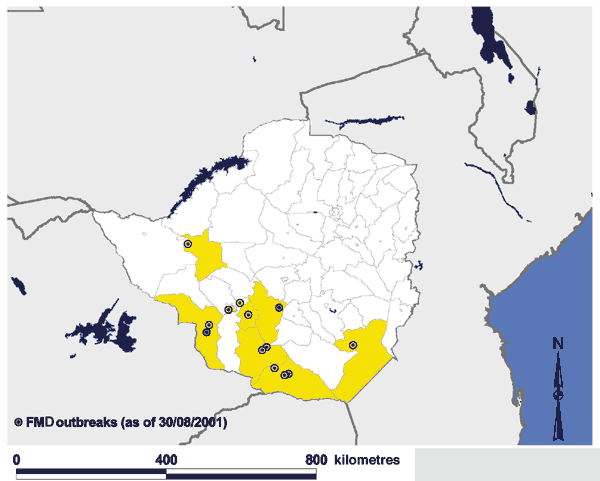Foot-and-mouth disease (FMD) was clinically detected recently in Zimbabwe, a country known as an exporter of meat. The outbreaks have adversely affected the meat industry. The estimated economic loss will be in the region of Z$ 100 billion (US$1.8 billion) per year if the disease is not controlled. This was the first incidence after the reported cases of nearby South Africa and Swaziland (see EMPRES Bulletin No. 15/3-4 - 2000).
FAO is currently providing emergency assistance to the Department of Veterinary Services, through a project entitled "Emergency assistance to control foot-and-mouth disease outbreak" (TCP/ZIM/0168).
The disease was first detected on 16 August in a cattle feedlot in southwestern Zimbabwe. Infection was caused by the SAT 2 virus.
A new outbreak was recorded on 8 September at Dibilashaba communal lands in Gwanda District, Matabeleland South Province. Seventeen properties were infected, mostly in Matabeleland North and South Provinces, situated in the northwest of the country. The virus type was again confirmed as the (FMD) SAT 2. However, the situation has since stabilized and infection remains confined to the quarantine zones instituted around the 17 infected premises.
Two virus strains suspected
Emerging indications point to the fact that there are two sources of infection in the Zimbabwe outbreaks, both originating from the African buffalo species.
The virus strain from Sobendle dip tank in the Lupane district of Matabeleland North Province was earlier suspected to be the cause of all the outbreaks. However, laboratory analyses indicate that the outbreak strain isolated from samples of infected cattle at Sobendle dip tank, near the Mzola forest Chirisa/Chizarira safari areas and housing African buffaloes, is marginally different from other isolates submitted from the Bulawayo/West Wicholson/Beitbridge infected areas. The blood samples for FMD serological screening were taken from the different locations of Willsgrove feedlot (Bulawayo district) and Sobendle dip tank (Lupane district), both found in Matabeleland North province. Samples were also taken from the Jopempi resettlement scheme (Beitbridge area, Matabeleland South Province), where suspected FMD was reported on 27 August. The laboratory analyses were conducted at the Onderstepoort Institute for Exotic Diseases.
Infection is believed to have spread through the illegal movement of cattle by motor transport through the area of Sobendle dip tank to the more lucrative market around Bulawayo.
Escaped buffaloes from the wildlife areas where surrounding fences had earlier been damaged are also suspected. Previously, buffaloes had been moved from Chirisa/Chizarira safari areas in the north to the game sanctuaries in the southern parts of the country, as a restocking exercise following the 1991/92 drought. A few wild African buffaloes, which are suspected to have escaped from nearby wildlife areas, have been observed in the vicinity of the outbreaks. Efforts to capture and obtain probang samples from these buffaloes are continuing. Also continuing are serological investigations into the source of the West Wicholson/Beitbridge outbreaks mentioned above.

The authorities fight back
As a control measure, a quarantine zone was instituted around all properties infected in Matabeleland North and South Provinces and at Triangle feedlot in Masvingo Province. In view of the above, the authorities in Zimbabwe have proposed to exclude the two provinces of Matabeleland North and South from the country's future export zone. A vaccination programme has also been put in place by the veterinary authorities. Currently, about 230 000 cattle have benefited from the programme, using the trivalent and monovalent SAT 2 vaccines, and the government plans to vaccinate more cattle at risk. The movement of people and vehicles to and from infected properties is restricted, while the progressive lifting of cattle movement restrictions in the rest of the country is under way. A disease report hotline and a Web site for FMD information have also been created. The Web site can be accessed at the following address: www.africaonline.co.zw/vet/FMD.htm. Daily situation reports, including maps, can be found, together with a detailed description of the disease and a Veterinary Department response plan.
Other control options adopted include mounting 18 roadblocks at strategic exit points from the affected regions. The authorities have also decided that all cattle at infected properties will be slaughtered and deboned for human consumption at specified registered abattoirs. As for branding, all cattle at affected properties will be branded "S'' for permanent identification for possible slaughter or movement into the traditional FMD vaccination (buffer) zone. Cattle vaccinated outside the buffer zone will be hot-iron branded with an inverted "V".
Surveillance measures and strict movement controls are continuing. Livestock inspections have been intensified in herds within a 40 km radius of infected premises. To date, a total of 400 000 cattle have been inspected.
Source: The Zimbabwean Veterinary Department's Web site: www.africaonline.co.zw/vet/FMD.htm